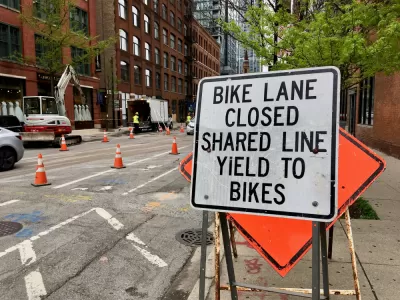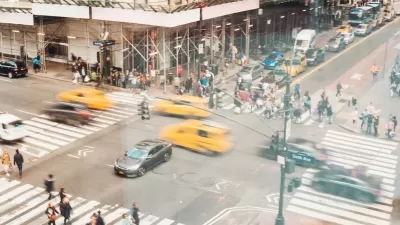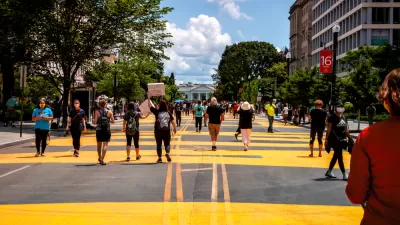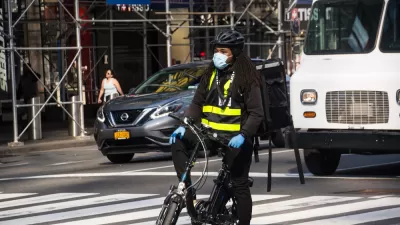Vision Zero pledges in New York City and Washington, D.C. have failed to slow the carnage on streets and roads—traffic fatalities are only increasing. It's time to start over.

Gersh Kuntzman shares the findings of a new report by Transportation Alternatives that analyzes traffic fatality data for New York City.
"Last month was the deadliest April since Mayor de Blasio took office in 2014 — and 2021, his last year in office, is on track to be the second deadliest year for road violence of his tenure, despite seven-plus years after the city officially adopted the Vision Zero initiative," writes Kuntzman to summarize the report's most topical findings.
Kuntzman shares more specifics, among others listed in the article:
- "Through April 30, 70 New Yorkers were killed in traffic violence — the deadliest start of any year since 2014 (when there were 72 fatalities)."
- "The pedestrian death toll is staggering: 43 pedestrians have been killed so far this year — the deadliest first four months for walkers of any year since Mayor de Blasio took office."
With statistics like that, the narrative about the success of Vision Zero in New York City has clearly changed since Mayor de Blasio touted the program's success on Queens Boulevard in Brooklyn, once known as the Boulevard of Death, in 2017.
Kuntzman also notes the prescriptions for traffic fatality reductions included in the Transportation Alternatives report, including fast tracking design improvements like those on Queens Boulevard in other parts of the city, creating more car-free spaces, and funding the city's Streets Master Plan, among other suggestions.
Reevaluating and reformulating Vision Zero is also the focus of a recent series of posts by Conor Shaw and Nick Sementelli for Greater Greater Washington, which offers solutions for Washington, D.C.'s Vision Zero program "after six years of failure."
People of every age, from all walks of life, using any form of transportation are more vulnerable today than they were when Mayor Bowser launched Vision Zero six years ago. When the campaign was announced, DC had experienced 26 fatalities on our streets the previous year. The Mayor was unambiguously clear in her goal: these deaths were unacceptable and, more importantly, preventable. “By 2024 we will do everything in our power to eliminate transportation fatalities or serious injuries.”
The 2016 report set an explicit target. To get to zero deaths on schedule, the District needed to see a 35% reduction every year. But the reality is that DC is not making any progress. Instead, things have gotten steadily worse: 37 people were killed last year, a 40% increase over the 2015 baseline.
To get Vision Zero back on track, Shaw and Sementelli suggest following the success of other cities, like Oslo, in slowing down automobiles and adopting a strategies actually show to "protect lives, increase mobility, and achieve greater equity in transportation." More specifics are added in a separate, follow up post, including:
- Implementing emergency "road diets" by reducing lanes on all arterial streets
- Reducing speed limits on all roads
- Deploying automated speed enforcement
- Reappropriating street space for public transportation, walking, and micromobility
- Making safe transportation modes free and charging more for deadly forms of transportation
- Adding oversight for the work of the District Department of Transportation and the City Council toward Vision Zero goals.
A lot more detail on each of those prescriptions is available in the source article.
It is not delusional to work toward Vision Zero goals—even if it's hard to look around at the results of Vision Zero programs, such as they are, and not tend toward skepticism. The city of Hoboken has implemented major changes to its streets, for example, and earlier this year completed a third year without traffic fatalities. For more prescriptions for how to actually commit to ending traffic fatalities, see a Planetizen feature by Angie Schmitt.
FULL STORY: Vision Zero in Decline: New Stats Show Blood Tide of Road Violence is Unchecked

Study: Maui’s Plan to Convert Vacation Rentals to Long-Term Housing Could Cause Nearly $1 Billion Economic Loss
The plan would reduce visitor accommodation by 25,% resulting in 1,900 jobs lost.

North Texas Transit Leaders Tout Benefits of TOD for Growing Region
At a summit focused on transit-oriented development, policymakers discussed how North Texas’ expanded light rail system can serve as a tool for economic growth.

Using Old Oil and Gas Wells for Green Energy Storage
Penn State researchers have found that repurposing abandoned oil and gas wells for geothermal-assisted compressed-air energy storage can boost efficiency, reduce environmental risks, and support clean energy and job transitions.

Santa Barbara Could Build Housing on County Land
County supervisors moved forward a proposal to build workforce housing on two county-owned parcels.

San Mateo Formally Opposes Freeway Project
The city council will send a letter to Caltrans urging the agency to reconsider a plan to expand the 101 through the city of San Mateo.

A Bronx Community Fights to Have its Voice Heard
After organizing and giving input for decades, the community around the Kingsbridge Armory might actually see it redeveloped — and they want to continue to have a say in how it goes.
Urban Design for Planners 1: Software Tools
This six-course series explores essential urban design concepts using open source software and equips planners with the tools they need to participate fully in the urban design process.
Planning for Universal Design
Learn the tools for implementing Universal Design in planning regulations.
Ascent Environmental
Borough of Carlisle
Institute for Housing and Urban Development Studies (IHS)
City of Grandview
Harvard GSD Executive Education
Toledo-Lucas County Plan Commissions
Salt Lake City
NYU Wagner Graduate School of Public Service





























